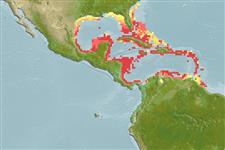Common names from other countries
Environment: milieu / climate zone / depth range / distribution range
Ecología
; rango de profundidad 0 - 58 m (Ref. 848). Subtropical; 33°N - 8°N, 98°W - 58°W (Ref. 848)
Western Atlantic: Gulf of Mexico, Caribbean Sea and Bermuda.
Length at first maturity / Tamaño / Peso / Age
Maturity: Lm ? range ? - ? cm
Formation: solid, rounded, often circular plates. Valleys: continuous, broad, shallow but sometimes deep; radiating from the original point of growth; with one row of mouths; short walls possible. Septo-costae possibly thinner than intervening spaces. Corallite centers: vaguely concentric to plate margins. Rudimentary or absent columellae. Color: often mottled gray or brown; also combinations of pink, green, and gray, with valleys and walls of contrasting colors (Ref. 848).
Maximum depth from Ref. 116012.
Life cycle and mating behavior
Madurez | Reproducción | Puesta | Huevos | Fecundidad | Larva
Members of the class Anthozoa are either gonochoric or hermaphroditic. Mature gametes are shed into the coelenteron and spawned through the mouth. Life cycle: The zygote develops into a planktonic planula larva. Metamorphosis begins with early morphogenesis of tentacles, septa and pharynx before larval settlement on the aboral end.
Cairns, S.D., D.R. Calder, A. Brinckmann-Voss, C.B. Castro, D.G. Fautin, P.R. Pugh, C.E. Mills, W.C. Jaap, M.N. Arai, S.H.D. Haddock and D.M. Opresko. 2003. (Ref. 1663)
IUCN Red List Status (Ref. 130435: Version 2024-1)
CITES status (Ref. 108899)
Not Evaluated
Human uses
| FishSource |
Herramientas
Más información
Age/SizeCrecimientoLength-weightLength-lengthMorfologíaLarvaAbundancia
Fuentes de Internet
Estimates based on models
Preferred temperature
(Ref.
115969): 25.3 - 28.1, mean 27 (based on 148 cells).
Price category
Unknown.
